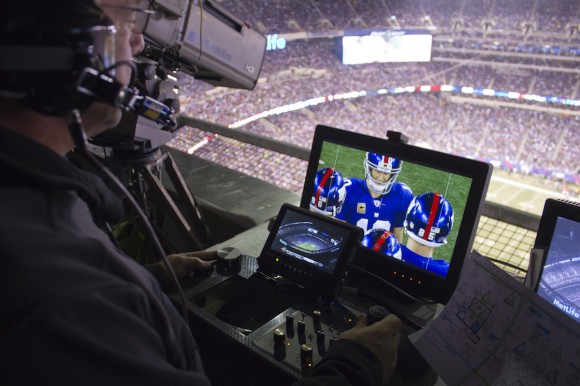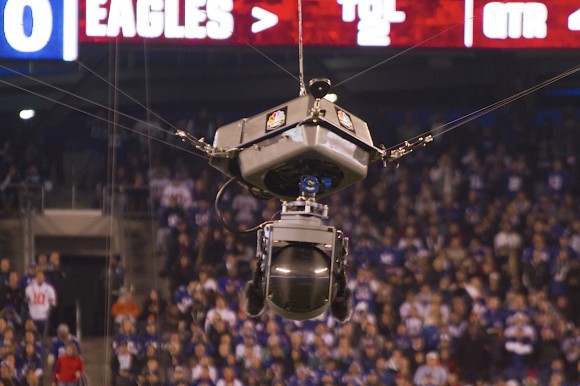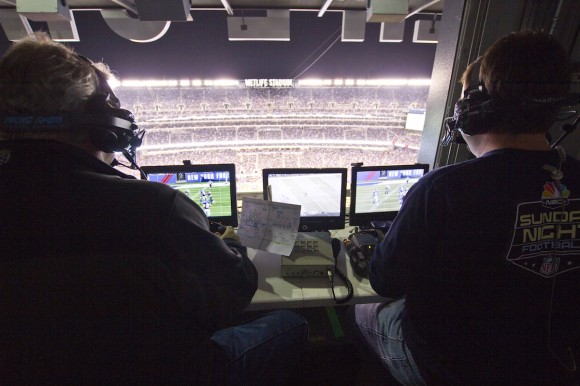Cablecam: The Eye in the Sky
Don Canfield is arguably one of the most knowledgeable and accomplished motion control operators in the country. Don’s 20+ years in the industry operating and innovating at the highest levels of sophistication within the niche area of advanced motion control hardware and techniques has nobly served and entertained he and the public very well.
What is work, if nothing shy of entertaining for a professional who loves what he is doing. I was told that reaching the pinnacle of success was when you are getting paid to do a job you would do for free. Certainly providing this video-game view to the public does come at a cost. Based on an article written in the LA Times (2008), $50,000 a game is the estimate.
The closest statement I can use to describe the end results of Don’s work with Cablecam in providing shots of the New York Giants at play, is that he and his team provide a God’s-eye view of the game. Interesting term “God’s-eye view.” I first came across it as I walked around the glass-floored balcony of The Panorama of the City of New York, a crown jewel in the collection of the Queens Museum of Art. Built by Robert Moses (1964) for the Worlds Fair. It’s 9,335 square feet of every single building in New York constructed before 1992 in a miniaturized version of the five boroughs (one inch equals 100 feet) all rendered within a contractually guaranteed one percent margin of error. The balcony of glass allowed me to look over as well as through the clear vertical wall. More importantly, clear through the floor to all the elements of New York City that lay under my feet in miniature all as if I were free flying overhead.
And why even mention all of that? Well, I had thought! It came to me during the interview with Don that his life’s work has been advancing technology and technique from the big to the small. Respectively concerning physical size and shape, motion and control, to give us that view of REAL LIFE. Let’s call it the Godzilla view this time. Real life views from an unreal perspective that only through the evolution of technology and the well honed technical craftsmanship of men like Don, are we able to enjoy such works as contained in his Filmography of over 30 titles as Motion Camera Operator/Visual Effects Supervisor. Dons’ credits also extend voluminously across Television and Commercial work as well.
Coming next is what’s truly special about sitting down with a guy having 25 years of hands on experience in the industry in which his path transcends the most integral parts of the development and application of motion control cameras. Sometimes it’s all about the wisdom and war stories, isn’t?
Sure it would be appropriate to now go on and list some facts and figures about the Cablecam System, which I’m going to do, however, more importantly after that’s done, get ready for the real meat of this story. That being how it all seems to come together over our lifetimes. This leads to that. That spins this off. He knows how to do this and that and so forth and so on…
Cablecam System Basics:
The Platform
- Pulleys
- Sending Signals (fiber optics)
- Camera (gyro-stabilized – High-Def)
The Cradle
- 2 ropes (X-Axis, Y-Axis)
- 3 motors (X-Axis Winch, Y-Axis Winch, Z-Axis Winch) = 6
The Crew
- 3 Riggers
- 1 Camera/Fiber Technician
- 1 Camera Operator aka Robo-Operator
- 1 Pilot = 6

Skycam Camera Operator at Giants Game.
The Controls
- Pilot (operates the platform)
- Camera Technician (operates the camera)
So I asked Don “where and how does this all begin? Tell me the story leading up to flying the Cablecam. There’s no University with a Cablecam 101 course available.” To which Don replies “My career path has taken me to become a motion control camera operator in Visual Effects, Film and Commercials. It’s only been in recent years that I’ve gotten into television sports through Cablecam because as they computerized their systems they started to use industry standard motion control software. They found me, with a few other people who knew that software to run their systems.” Interesting, so it seems like it’s a matter of professional organic grow that takes one to these heights. Don’s been with Cablecam for the last 6 years along with running his own company.
Gear+Rose, founded in 1998 with Don as Co-Founder/Motion Control Operator/Technical Consultant now solely at it’s helm, has built an veritable “A” List of credits. From stop motion animation, table top and live action commercials, music videos, TV promos to feature films, G+R delivers advanced portable motion control to New York and throughout the East (read world). As we duly sing the praises of Don and G+R let us not fail to mention that beyond motion control, they can help with camera data motion capture, data interpolation and post effects coordination for the porting of motion data to CGI.
“What’s the story between motion control and Cablecam?” I inquire. “Motion control is a robotically controlled camera systems who’s primary purpose is to shoot the same camera move multiple times. An example of that is Star Wars, which is more or less where motion control got it s start.” Star Wars, always seems to be only a few degrees of separation away from some aspect of technological history. “The first movie to use motion control to any extent was 2001: A Space Odyssey, however it was Star Wars that catapulted motion control off as an industry” Don elaborates.
“And the connection between Cablecam and Motion Control is what again?” I follow up. Don explains, “Even with today’s CGI there is still a lot of practical photography done to make CGI work. The use of robotically controlled camera’s (camera dolly’s that are motorized and computerized) are used to create a camera move, generating camera move data that can be duplicated on real people, objects and backgrounds. That computer technology is what Cablecam used at its start to control its cameras. They used a very, very small subset of all of the motion control tricks and applications that were available in the software to run their cameras up and down anything, by having three motors, running 2 ropes and have the cameras capable of going in a straight line in a 3 dimensional space.” (3 x 2 = 6)
Now my head is really spinning!!! “Don, what exactly are you then?” I had to ask, learning of this confluence of camera capture, mechanics, software programming on top of everything else. The answer was simple and spoken without a moment of hesitation “I’m a camera person. I basically operate a camera with a keyboard.”
It’s those simple answers that roll off the tongue as if nothing that always tell me there’s SO MUCH MORE to the story and I thank Mr. Canfield for sharing just that, he said “It’s a funny business that I work in. Almost everybody I work with has a college degree and nobody needs it. They have them because that’s the caliber of people I’m working with, yet it’s not part of the job description. They don’t care how you learned what you know as long as you know how to do it well.”
“I have a BFA in graphic design. Which is what got me into the 1- animation houses which is what got me into 2-graphic animation which is what got me into the 3-industry which got me into the 4-studios where I gravitated from 5-drawing boards to 6-cameras.
Amazing! As I sat and listened, I couldn’t help but notice the pattern of 6 emerging over and over again. The last thing I am is a numerologist and the first thought I had, being in “the business” was, with Don having a 30 Major Motion Picture Filmography, how FRIGGIN cool would it be to play 6 Degrees of Kevin Bacon to illustrate how randomly precise a journey of success looks. All using a game that actually represents the very serious science of COMPLEX NETWORKS, championed by Albert-László Barabási. Perhaps I’ll have to save that for a Part II Don Canfield story later down the road.
In closing I felt it my duty to ask Don “if there were one pearl of wisdom to pass on to someone who wants to do what you do, what would it be?” Here is what he said “A visual effects supervisor was once asked by a student, what should I take in college to become a really good Visual Effects Supervisor? The answer was surprisingly not as heavily weighted toward what you might expect, film and photography… rather it was a brilliantly distant yet connected, 1-engineering, 2-electronics, 3-chemistry, 4-literature, 5-math and 6-human resources.”
The best part of being granted the privilege of writing this story for Ferro and getting to know Don, is that at the conclusion of the editing process, I had a few minutes to catch up with Joe Scacciaferro of Ferro Productions. Joe an accomplished professional with many “industry credits and innovations” to his name, summed it all up and as such, validated and encapsulates this entire article by stating the following:
“Nobody ends up where they started and it seems if you do, your not any good.”
Follow @FerroProduction
~ Joe S.
View more photos from our facebook






Comments
One Response to “Cablecam: The Eye in the Sky”Trackbacks
Check out what others are saying...[…] Productions has an excellent featured article “6 DEGREES FROM ANIMATION“. Check it […]